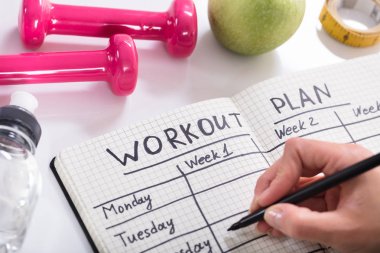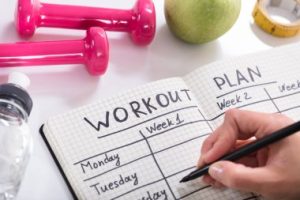
How To Design An Effective Workout Plan (9 Unique Guidelines)
How to design an effective workout plan: Begin by setting clear goals tailored to your fitness aspirations and abilities. Next, assess your current fitness level to determine a starting point for your routine. Finally, incorporate a balanced mix of cardiovascular, strength training, and flexibility exercises to create a comprehensive plan that promotes progress and avoids plateaus.
Embarking on the journey to craft the ultimate workout plan is akin to sketching the blueprint for your physical prowess. It’s not just about sweating it out in the gym or pounding the pavement; it’s about orchestrating a symphony of movements that harmonize with your body’s rhythm, sculpting it into a masterpiece of strength, agility, and endurance.
Crafting an effective workout plan isn’t merely about sets and reps; it’s about choreographing a dance between determination and strategy, sculpting your body and mind into a masterpiece of health and vitality. So, let’s delve into the artistry of fitness and uncover the brushstrokes that will paint your path to success.

How To Design An Effective Workout Plan
To design an effective workout plan, focus on setting clear goals and incorporating a balance of cardiovascular, strength, and flexibility exercises tailored to your fitness level and preferences. Consistency and progression are key for long-term success.
Set Clear Goals
Begin by defining your objectives, such as building strength, increasing endurance, or enhancing flexibility. Setting specific, measurable goals will guide your workout plan and help you track your progress effectively. Whether it’s running a 5K or squatting a certain weight, clarity is essential.
Assess Your Current Fitness Level
Conduct a thorough assessment of your current fitness level to determine your starting point. This includes evaluating strength, endurance, flexibility, and any existing injuries or limitations. Understanding where you are now will help you tailor your workouts to suit your needs and abilities.
Choose Appropriate Exercises
Select exercises that align with your goals and target different muscle groups for balanced development. Incorporate a variety of strength training, cardiovascular, and flexibility exercises to ensure comprehensive fitness. Consider your preferences, equipment availability, and any limitations when choosing exercises.
Establish a Structured Plan
Outline a structured workout plan that includes frequency, duration, and intensity of workouts. Gradually increase the challenge over time to prevent plateaus and continue making progress. Incorporate rest days to allow for recovery and prevent overtraining, promoting long-term sustainability.
Monitor and Adjust
Regularly monitor your progress and adjust your workout plan accordingly to stay on track towards your goals. Track metrics such as strength gains, endurance improvements, and body composition changes. Be flexible and willing to make modifications based on feedback from your body and performance.
Setting Goals
Specific Fitness Objectives
When crafting an effective workout plan, pinpointing specific fitness objectives is paramount. These objectives serve as the guiding light, directing the focus and intensity of your training regimen. Whether aiming to build muscle mass, enhance cardiovascular endurance, improve flexibility, or achieve weight loss, defining clear goals allows for tailored workouts that address individual needs.
Incorporating a mix of strength training, cardio, flexibility exercises, and rest days ensures a well-rounded approach to fitness. Moreover, setting realistic and measurable targets provides motivation and enables progress tracking. By aligning exercises and intensity levels with specific fitness objectives, individuals can design personalized workout plans that maximize results and foster long-term success.
Measurable and Achievable Goals
In designing an effective workout plan, establishing measurable and achievable goals is paramount. These goals serve as the roadmap to progress, ensuring that each workout session contributes meaningfully to overall fitness objectives. Measurable goals provide clear benchmarks for progress tracking, such as aiming to increase weight lifted, improve endurance, or decrease body fat percentage.
Achievable goals are realistic and within reach, considering factors like current fitness level, time commitments, and resources available. By setting goals that are both measurable and achievable, individuals can maintain motivation, stay focused, and celebrate milestones along the journey to optimal health and fitness.
Long-Term and Short-Term Goals
It’s crucial to delineate both long-term and short-term goals to ensure progress and motivation. Short-term goals act as stepping stones, providing immediate targets to strive for and indicating progress along the way. These could include increasing the number of repetitions or lifting heavier weights within a few weeks.
Long-term goals, on the other hand, provide a broader vision, guiding the overall direction of the fitness journey. These might involve achieving specific body composition changes, mastering advanced exercises, or completing a challenging event like a marathon. By balancing short-term achievements with long-term aspirations, individuals can maintain focus, celebrate milestones, and stay committed to their fitness regimen, ultimately fostering sustainable progress and success.

Assessing Current Fitness Level
Physical Assessment
Assessing your current fitness level is paramount in crafting an effective workout plan tailored to your individual needs and goals. Through a comprehensive physical assessment, including tests for cardiovascular endurance, muscular strength and endurance, flexibility, and body composition, you gain valuable insights into your strengths and areas for improvement.
These assessments provide a baseline from which progress can be measured, guiding the development of a personalized exercise regimen. Understanding your body’s capabilities and limitations allows for the creation of targeted workouts that maximize results while minimizing the risk of injury. Whether you’re a beginner embarking on a fitness journey or a seasoned athlete seeking to enhance performance, a thorough assessment sets the foundation for a successful training program, ensuring each workout is purposeful and efficient in driving progress towards your fitness aspirations.
Identifying Strengths and Weaknesses
By understanding your strengths and weaknesses, you can tailor your exercise regimen to address specific areas of improvement. This assessment often includes exercises like strength tests, endurance challenges, flexibility assessments, and body composition analysis. Once you have a clear understanding of where you stand, you can strategically plan your workouts to capitalize on your strengths and target your weaknesses. This personalized approach not only maximizes results but also minimizes the risk of injury by ensuring that workouts are appropriate for your current fitness level.
Consulting with a Fitness Professional
If navigating your fitness assessment feels daunting or you seek expert guidance, consulting with a fitness professional is invaluable. Personal trainers, physiotherapists, or sports therapists possess expertise to interpret assessment results accurately. They can provide tailored exercise programs and nutritional advice to optimize your fitness journey.
Exercise Selection
Choose exercises that align with goals and preferences
It’s crucial to select exercises that harmonize with both your fitness goals and personal preferences. Whether aiming to build strength, enhance cardiovascular health, or improve flexibility, tailoring exercises to align with these objectives ensures maximum efficiency and satisfaction. Consider incorporating a variety of activities, such as weightlifting, cardio routines, yoga, or sports-specific drills, to maintain interest and target different muscle groups.
Additionally, factor in your preferences and enjoyment levels to foster consistency and motivation throughout your fitness journey. By selecting exercises that resonate with your goals and preferences, you can design a workout plan that not only yields results but also brings fulfillment and enjoyment to your fitness regimen.
Incorporate a variety of exercises to target different muscle groups and movement patterns
Designing an effective workout plan involves incorporating a variety of exercises to target different muscle groups and movement patterns. By diversifying your routine, you ensure comprehensive muscle development and functional fitness. Begin with compound exercises like squats, deadlifts, and bench presses to engage multiple muscle groups simultaneously, promoting strength and coordination.
Incorporate isolation exercises such as bicep curls, tricep extensions, and leg extensions to focus on specific muscles and address any weaknesses. Additionally, include functional movements like lunges, rows, and planks to enhance stability, mobility, and overall athleticism. By incorporating a mix of exercises that target various muscle groups and movement patterns, you create a well-rounded workout plan that promotes balanced strength development and reduces the risk of overuse injuries.

Consider equipment availability and accessibility
When crafting an effective workout plan, it’s crucial to consider equipment availability and accessibility. Assessing the resources at your disposal ensures that your plan is both practical and achievable. Whether you’re working out at home, a gym, or outdoors, understanding what equipment you have access to can help tailor exercises to maximize effectiveness.
Additionally, considering the versatility of equipment allows for a diverse range of exercises targeting various muscle groups. Prioritizing accessibility ensures that your plan accommodates different fitness levels and physical abilities, promoting inclusivity and long-term adherence. By thoughtfully incorporating available equipment into your workout routine, you can design a plan that optimizes results and fosters consistency.
Workout Structure
Warm-up
A solid workout structure lays the foundation for effective fitness routines, with a crucial starting point being the warm-up. This preliminary phase primes the body for the forthcoming physical exertion, gradually increasing heart rate, blood flow, and joint mobility. A well-designed warm-up typically includes dynamic stretches, light cardio activities, and mobility exercises tailored to the specific muscles and movements targeted during the workout.
By gently awakening the muscles and lubricating the joints, the warm-up not only reduces the risk of injury but also enhances overall performance during the main workout session. It serves as a bridge between rest and intense activity, mentally preparing the individual while physically preparing the body to tackle the challenges ahead.
Main Workout
A well-designed workout structure forms the backbone of any fitness regimen, ensuring optimal progress and results. At its core lies the main workout session, the focal point where the sweat is shed and the gains are made. This segment typically encompasses a series of exercises targeting different muscle groups or fitness goals, meticulously arranged to maximize efficiency and effectiveness.
Whether it’s a high-intensity interval training circuit or a classic strength training routine, the main workout is where individuals push their limits, striving to surpass previous achievements and reach new heights of strength, endurance, and overall fitness. With proper planning and execution, the main workout becomes not just a physical endeavor, but a journey of self-improvement and empowerment.
Cool-down
The cool-down phase of a workout is as crucial as the warm-up and main workout itself. It marks the gradual reduction of intensity, allowing the body to transition from a state of high exertion back to its resting state. Incorporating stretching exercises during this phase helps to gradually lower heart rate, prevent muscle soreness, and improve flexibility.
Cooling down also aids in dissipating lactic acid buildup, reducing the risk of post-exercise stiffness and injury. Additionally, it serves as a mental cooldown, allowing individuals to reflect on their performance and achievements during the workout session while promoting relaxation and stress relief. By allocating time for a proper cool-down, individuals can optimize their overall fitness routine and enhance their recovery process.

Workout Frequency and Duration
Determine how many days per week to exercise
The optimal workout frequency and duration vary depending on individual fitness goals, current fitness level, and overall lifestyle. Generally, it’s recommended to engage in moderate to vigorous aerobic exercise for at least 150 minutes per week, spread across several days. For strength training, aim for two to three sessions per week, focusing on all major muscle groups.
Balancing intensity and recovery is crucial to avoid overtraining and injury, so incorporating rest days into the routine is essential. Ultimately, finding the right balance of workout frequency and duration involves listening to your body, gradually increasing intensity over time, and consulting with a fitness professional if needed.
Balance between intensity and recovery
Finding the right balance between workout frequency and duration is crucial for achieving optimal results in fitness. While consistency is key, overtraining can lead to burnout and injuries, hindering progress. It’s important to tailor the frequency and duration of workouts to individual fitness levels, goals, and recovery capabilities. Generally, a mix of high-intensity sessions interspersed with adequate rest periods allows the body to adapt and grow stronger. Incorporating variety in workouts also prevents plateaus and keeps motivation high.
Adjustments based on individual factors (e.g., fitness level, schedule)
Understanding one’s fitness level allows for tailored exercise regimens that challenge without overwhelming, ensuring steady progress while minimizing the risk of injury. Meanwhile, accommodating one’s schedule acknowledges the diverse demands of daily life, enabling the integration of healthy habits seamlessly. Whether it’s squeezing in a quick workout during a busy day or opting for nutritious yet time-efficient meal options, these adjustments foster a balanced lifestyle that aligns with individual needs and priorities. By embracing these considerations, individuals can navigate their wellness journey with greater flexibility and success.
Progression and Variation
Progression: Gradually increase intensity, duration, or load over time
In fitness and training, progression is key. It involves steadily ramping up the challenge to avoid stagnation and stimulate growth. This can mean increasing weights, reps, or workout duration gradually. It’s like climbing a ladder, step by step, to reach new heights. By pushing your limits sensibly, you stimulate muscle adaptation and improve endurance. Whether you’re a beginner or a seasoned athlete, progression is essential for continual improvement.
Variation: Incorporate variety to prevent plateaus and boredom
Variation is the spice of fitness life. It’s about mixing things up to keep your body guessing and engaged. Instead of doing the same routine day in and day out, add diversity. Try different exercises, change your workout environment, or explore new activities. This prevents plateaus and keeps boredom at bay. It’s like exploring different paths to reach the same destination. By embracing variety, you challenge different muscle groups and avoid overuse injuries.
Monitoring: Monitor progress and adjust accordingly
Monitoring your progress is like having a GPS for your fitness journey. It involves tracking metrics like weight lifted, distance run, or body measurements. This allows you to see how far you’ve come and where you’re headed. If you notice stagnation or regression, it’s time to adjust your approach. This might mean tweaking your workouts, reassessing your goals, or seeking expert guidance. By staying vigilant and adaptable, you ensure continued growth and success.
Recovery and Rest
Importance of rest days
Rest days are not just breaks from physical activity; they are essential components of any effective fitness regimen. These periods of recovery allow the body to repair and strengthen itself, minimizing the risk of injury and fatigue while maximizing performance gains. Physiologically, rest days enable muscles to rebuild and grow stronger, replenish energy stores, and regulate hormonal levels.
Moreover, they promote mental rejuvenation, reducing stress and preventing burnout. Incorporating rest days into a training schedule is crucial for sustaining long-term progress and overall well-being, emphasizing the importance of balance between exercise and recovery in achieving optimal health and fitness goals.
Strategies for active recovery (e.g., yoga, light stretching)
Active recovery encompasses a variety of strategies aimed at promoting physical and mental rejuvenation following intense exercise. Among these, yoga and light stretching emerge as particularly effective methods. Yoga, with its focus on controlled breathing, gentle movements, and mindfulness, not only enhances flexibility and mobility but also promotes relaxation and stress reduction.
Similarly, light stretching routines target specific muscle groups, aiding in the alleviation of soreness and stiffness while improving circulation. Both practices facilitate the removal of metabolic waste products from muscles, accelerating the recovery process and preparing the body for future workouts. Incorporating these activities into a post-exercise regimen can enhance overall well-being, promoting balance and longevity in one’s fitness journey.
Adequate sleep and nutrition
Adequate sleep and nutrition are two pillars of overall health and well-being. Sleep provides our bodies with the essential restorative period needed for physical and mental rejuvenation. It supports cognitive function, mood regulation, and immune system strength. Similarly, nutrition fuels our bodies, providing the necessary nutrients for optimal functioning.
A balanced diet rich in vitamins, minerals, proteins, and carbohydrates is vital for sustaining energy levels, supporting organ function, and promoting overall vitality. When combined, sufficient sleep and proper nutrition form a powerful synergy, enhancing resilience against illness, improving mood, and fostering long-term health. Prioritizing these fundamental aspects of self-care lays the foundation for a vibrant and fulfilling life.
Monitoring and Evaluation
Workout Journaling for Progress Tracking
Workout journaling is an indispensable tool for anyone committed to their fitness journey. It serves as a comprehensive record of your exercises, progress, and achievements, providing invaluable insights into your fitness trajectory. By meticulously logging each workout session, including details such as sets, reps, weights, and even subjective factors like mood and energy levels, you gain a clear understanding of your strengths, weaknesses, and areas for improvement.
This data-driven approach empowers you to make informed decisions about your training regimen, adjust intensity and volume accordingly, and set realistic goals. Moreover, tracking your progress over time not only boosts motivation but also fosters accountability, as you hold yourself accountable to the goals you’ve set. Ultimately, a workout journal becomes more than just a record-keeper; it becomes a roadmap to success, guiding you towards continuous improvement and optimal performance.
Regular Goal Reassessment for Effective Planning
Regular goal reassessment is an indispensable component of effective planning, ensuring adaptability and progress. By periodically reviewing goals, individuals and organizations can recalibrate their strategies in response to changing circumstances, emerging opportunities, or unforeseen obstacles. This practice fosters agility and resilience, enabling stakeholders to pivot when necessary while staying aligned with overarching objectives.
Moreover, regular reassessment promotes accountability and clarity, as it allows for the refinement of goals based on feedback and evolving priorities. Ultimately, integrating regular goal reassessment into planning processes cultivates a dynamic and forward-thinking approach, empowering individuals and organizations to navigate complexity with purpose and precision.
Body Listening for Optimal Adjustments
Body listening for optimal adjustments involves attuning oneself to the subtle cues and signals that the body communicates, allowing for precise and effective adjustments. It’s a holistic approach that integrates physical, mental, and emotional awareness, fostering a deeper connection between the practitioner and the recipient. Through keen observation and intuition, practitioners can identify areas of tension, imbalance, or discomfort, guiding them in tailoring adjustments to address specific needs. By honoring the body’s wisdom and responding with sensitivity, body listening facilitates profound relaxation, realignment, and rejuvenation, promoting overall well-being and vitality.
Frequently Asked Questions (FAQ) About How To Design An Effective Workout Plan
Q1. What are the key components of a well-rounded workout plan?
A. A balanced workout plan typically includes cardiovascular exercise, strength training, flexibility exercises, and rest days.
Q2. How do I determine the right intensity for my workouts?
A. Intensity can vary based on fitness level and goals. Beginners should start with moderate intensity and gradually increase. Advanced individuals might incorporate high-intensity intervals or heavy lifting.
Q3. How often should I work out each week?
A. It depends on your goals, but most people benefit from exercising at least three to five times a week, with a mix of cardio and strength training.
Q4. What’s the importance of warming up and cooling down?
A. Warming up prepares your body for exercise by increasing blood flow and flexibility, while cooling down helps your body recover and reduces muscle soreness.
Q5. Should I focus on specific muscle groups each day or do full-body workouts?
A. Both approaches can be effective. Some prefer split routines targeting specific muscle groups each day, while others prefer full-body workouts for overall conditioning.
Q6. How do I progress in my workouts over time?
A. Progression can involve increasing weight, reps, sets, or intensity gradually to continually challenge your body and avoid plateaus.
Q7. What role does nutrition play in my workout plan?
A. Nutrition is crucial for fueling workouts, aiding in recovery, and supporting muscle growth. A balanced diet with adequate protein, carbohydrates, and fats is important.
Q8. How do I prevent injuries while working out?
A. Proper form, adequate rest, and listening to your body are key. Gradually increasing intensity and incorporating recovery days can also help prevent overuse injuries.
Q9. Is it necessary to incorporate rest days into my workout plan?
A. Yes, rest days are essential for muscle recovery and overall health. They allow your body to repair and rebuild, reducing the risk of burnout and overtraining.
Q10. How do I stay motivated to stick to my workout plan?
A. Setting realistic goals, tracking progress, varying your routine, and finding activities you enjoy can all help maintain motivation and consistency.
Conclusion
In conclusion, designing an effective workout plan requires careful consideration of various factors, including individual goals, fitness level, preferences, and lifestyle constraints. By incorporating elements such as specificity, progression, variety, and balance, individuals can create a plan that not only targets their desired outcomes but also promotes long-term adherence and sustainability. Additionally, regular evaluation and adjustment of the plan based on feedback and progress are essential to ensure continued effectiveness and prevent plateaus. Ultimately, a well-designed workout plan not only helps individuals achieve their fitness goals but also enhances their overall health and well-being, empowering them to lead active and fulfilling lives.